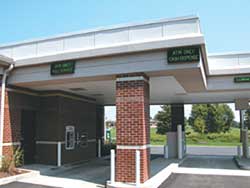Illuminating Changes
Great improvements have been made in brightness and longevity, both of which have enabled LEDs to enter the signage industry.
- By Keith Miller
- Dec 01, 2005
 TRADITIONAL methods for illuminating signage are giving way to new/old technology. I say new/old because Light Emitting Diodes, or LEDs, have been around since the 1960s. The technology has caught up and enabled LEDs to become commonplace within the last five to seven years because of new processes and the fact that materials have become less expensive to produce.
TRADITIONAL methods for illuminating signage are giving way to new/old technology. I say new/old because Light Emitting Diodes, or LEDs, have been around since the 1960s. The technology has caught up and enabled LEDs to become commonplace within the last five to seven years because of new processes and the fact that materials have become less expensive to produce.
The greatest improvements have been made in brightness and longevity, both of which have enabled LEDs to enter the signage industry.
What is a LED, you may ask. LEDs consist of a compound semiconductor diode encapsulated in a plastic package or protective coating. The package can be tinted the same color of the LED or waterclear because the color is coming from photons being radiated from the junction where electrons meet. The color of the light being emitted is determined by the gap of the semiconductor. LEDs using AllnGaP alloys emit light in the yellow red spectrum. LEDs using AllnGaN semiconductors alloys emit light in the blue green to UV spectrum. White can be created by coating the inside of the package with phosphors.
LEDs possess many advantages over other light sources. Because there is no filament, LEDs are resistant to vibratory conditions. LEDs produce little to no heat by being so efficient that they don't need to heat up a filament to create light as an incandescent light bulb does. No heat also results in another benefit: long life.
A common light bulb averages about 5,000 hours of life. An LED, driven properly, averages about 100,000+ hours, equivalent to more than 11 years. And that is without being turned off.
Okay, so we have long life, little to no heat, and resistance to vibration. How about adding another benefit that is on everyone's mind (or should be, for that matter)--energy savings. Because LEDs are low voltage, a sign created with them uses about 10 percent of the electricity that a similar sign being illuminated with a different light source would use.
Visible in Sunlight
All of these savings add up over the life of the LED sign. There are no maintenance requirements; no one has to be there to change a light bulb when one burns out. Increased safety is critical situations is gained because of the reliability of the light source. An LED sign could pay for itself just in the savings alone.
The benefits I've mentioned combine to create a sign that is extremely practical for safety-oriented usage. Used in applications such as busy forklift areas or blind intersections, these signs can be enhanced with sensors and programmed to illuminate and flash when a forklift approaches. Another application is overhead clearance bars with illuminated LED messages warning of the low clearance height. These too, can also be made to flash when a object breaks a infrared beam placed at a set height. Again, the very bright, intense LED message attracts attention and can avoid catastrophe.
With the benefits of low voltage, small size, and low maintenance, many backlit LED signs are making their way into hospitals, where they warn people of hazardous conditions such as X-RAYS or MRI IN USE, CT, and WARNING LASER IN USE. These signs "blank-out" and have just a black face when they are turned off, eliminating any possible confusion.
In the sign industry, LEDs can be used to illuminate a message's face panel from the back. This involves using a matrix of LEDs to illuminate the whole face. This is also the traditional way neon and incandescent backlit signs operate.
Additionally, signs can be created with the LEDs visible, or what is called Direct-View. This is accomplished by placing the LEDs in line with the letters of the desired message. These signs have the benefit of being viewable in direct sunlight without the use of a sun visor or sun screen.
This is an exciting time in the life of the LED. You probably viewed many LEDs on your drive to work this morning, at the traffic light, the pedestrian crossing, or when the car in front of you stopped and its brake lights came on, and of course in many signs. The future holds many more uses for the LED.
This article appeared in the December 2005 issue of Occupational Health & Safety.
This article originally appeared in the December 2005 issue of Occupational Health & Safety.
About the Author
Keith Miller is Creative Director for Signal-Tech of Erie, Pa. Signal-Tech manufactures LED "blank out" signs, LED displays, custom LED signs, neon signs, and Directional Signal lights that are used by companies in the banking and parking industries, car washes, airports, hospitals, casinos, loading docks, highway toll lanes, colleges, and many more. The company's founders in 1954 originated the first neon backlit OPEN/CLOSED sign. Phone 814-835-3000, fax 814-835-2300 to contact him.